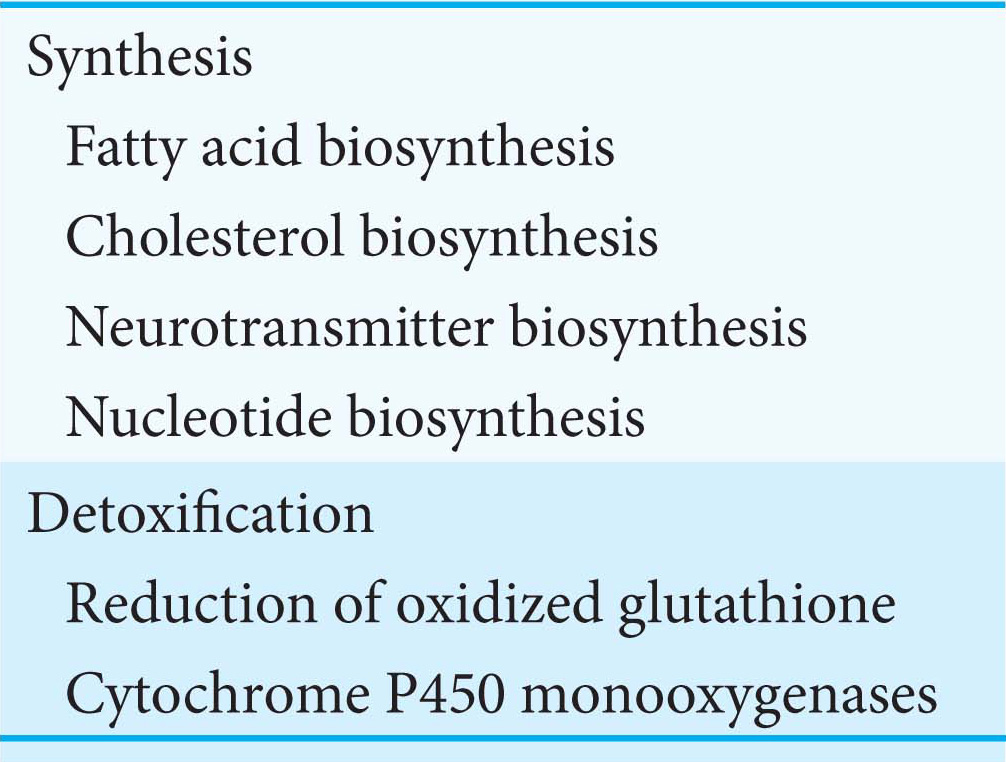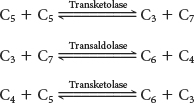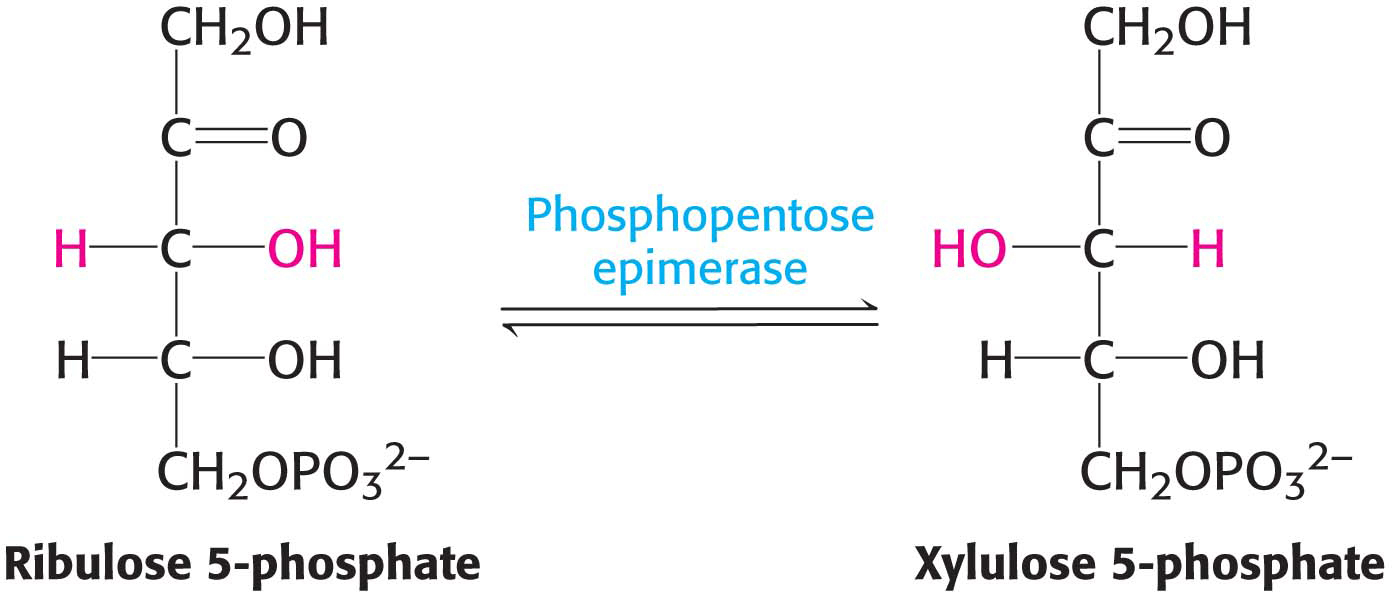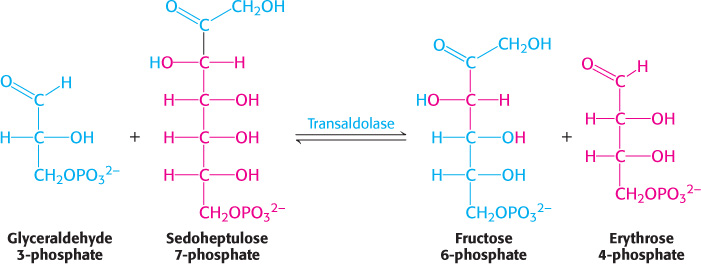26.1 The Pentose Phosphate Pathway Yields NADPH and Five-Carbon Sugars
✓ 6 Identify the two stages of the pentose phosphate pathway, and explain how the pathway is coordinated with glycolysis and gluconeogenesis.

Table 26.1 Pathways requiring NADPH
Recall that, in photosynthesis (Chapter 22), NADPH is a key product of the light reactions. NADPH is the source of biosynthetic reducing power in all organisms and is used in a host of biochemical processes (Table 26.1). How do nonphotosynthetic cells and organisms generate NADPH? The metabolism of glucose 6-phosphate by the pentose phosphate pathway generates NADPH for nonphotosynthetic organisms. This pathway consists of two phases: (1) the oxidative generation of NADPH and (2) the nonoxidative interconversion of sugars (Figure 26.1). In the oxidative phase, NADPH is generated when glucose 6-phosphate is oxidized to ribulose 5-phosphate:

Figure 26.1: The pentose phosphate pathway. The pathway consists of (1) an oxidative phase that generates NADPH and (2) a nonoxidative phase that interconverts phosphorylated sugars.
Ribulose 5-phospate is subsequently converted into ribose 5-phosphate, which is a precursor to RNA and DNA as well as to ATP, NADH, FAD, and coenzyme A. In the nonoxidative phase, the pathway catalyzes the interconversion of three-, four-, five-, six-, and seven-carbon sugars in a series of nonoxidative reactions. Excess five-carbon sugars may be converted into intermediates of the glycolytic pathway. All these reactions take place in the cytoplasm.
Two Molecules of NADPH Are Generated in the Conversion of Glucose 6-phosphate into Ribulose 5-phosphate
The oxidative phase of the pentose phosphate pathway starts with the oxidation of glucose 6-phosphate at carbon 1 with the concomitant formation of NADPH, a reaction catalyzed by glucose 6-phosphate dehydrogenase (Figure 26.2). This dehydrogenase is highly specific for NADP+; the KM for NAD+ is about a thousand times as great as that for NADP+. The product of the dehydrogenation is 6-phosphoglucono-δ-lactone, which has an ester between the C-1 carboxyl group and the C-5 hydroxyl group. The next step is the hydrolysis of 6-phosphoglucono-δ-lactone by a specific lactonase to give 6-phosphogluconate. This six-carbon acid is then oxidatively decarboxylated by 6-phosphogluconate dehydrogenase to yield ribulose 5-phosphate. NADP+ is again the electron acceptor. This reaction completes the oxidative phase.

Figure 26.2: The oxidative phase of the pentose phosphate pathway. Glucose 6-phosphate is oxidized to 6-phosphoglucono-δ-lactone to generate one molecule of NADPH. The lactone product is hydrolyzed to 6-phosphogluconate, which is oxidatively decarboxylated to ribulose 5-phosphate with the generation of a second molecule of NADPH.
The Pentose Phosphate Pathway and Glycolysis Are Linked by Transketolase and Transaldolase
The preceding reactions yield two molecules of NADPH and one molecule of ribulose 5-phosphate for each molecule of glucose 6-phosphate oxidized. The ribulose 5-phosphate is subsequently isomerized to ribose 5-phosphate by phosphopentose isomerase.
Although ribose 5-phosphate is a precursor to many biomolecules, many cells need NADPH for reductive biosyntheses much more than they need ribose 5-phosphate for incorporation into nucleotides. For instance, adipose tissue, the liver, and mammary glands require large amounts of NADPH for fatty acid synthesis (Chapter 28). In these cases, ribose 5-phosphate is converted into glyceraldehyde 3-phosphate and fructose 6-phosphate by transketolase and transaldolase. These enzymes create a reversible link between the pentose phosphate pathway and glycolysis by catalyzing these three successive reactions (Figure 26.1):
The net result of these reactions is the formation of two hexoses and one triose from three pentoses:
The first of the three reactions linking the pentose phosphate pathway and glycolysis is the formation of glyceraldehyde 3-phosphate and sedoheptulose 7-phosphate from two pentoses:
DID YOU KNOW?
Epimers are isomers with multiple asymmetric centers that differ in configuration at only a single asymmetric center.
The donor of the two-carbon unit in this reaction is xylulose 5-phosphate, an epimer of ribulose 5-phosphate. Ribulose 5-phosphate is converted into the appropriate epimer for the transketolase reaction by phosphopentose epimerase:
In the second reaction linking the pentose phosphate pathway and glycolysis, glyceraldehyde 3-phosphate and sedoheptulose 7-phosphate react to form fructose 6-phosphate and erythrose 4-phosphate:
This synthesis of a four-carbon sugar and a six-carbon sugar is catalyzed by transaldolase.
In the third reaction, transketolase catalyzes the synthesis of fructose 6-phosphate and glyceraldehyde 3-phosphate from erythrose 4-phosphate and xylulose 5-phosphate:
The sum of these reactions is
Xylulose 5-phosphate can be formed from ribose 5-phosphate by the sequential action of phosphopentose isomerase and phosphopentose epimerase, and so the net reaction starting from ribose 5-phosphate is
!quickquiz! QUICK QUIZ
Describe how the pentose phosphate pathway and glycolysis are linked by transaldolase and transketolase.
Thus, excess ribose 5-phosphate formed by the pentose phosphate pathway can be completely converted into glycolytic intermediates. Moreover, any ribose ingested in the diet can be processed into glycolytic intermediates by this pathway. Evidently, the carbon skeletons of sugars can be extensively rearranged to meet physiologic needs (Table 26.2).

Table 26.2 The pentose phosphate pathway














